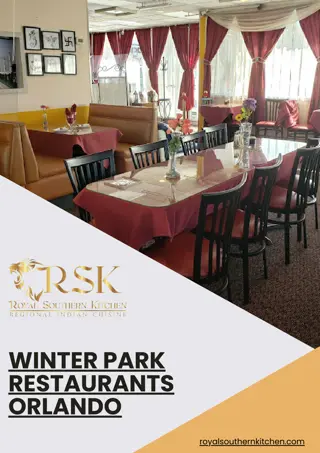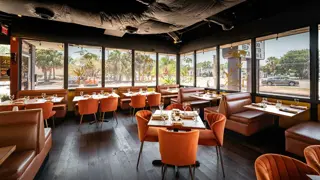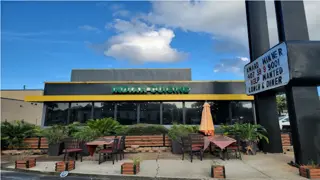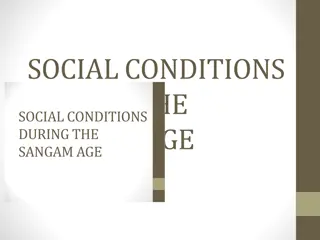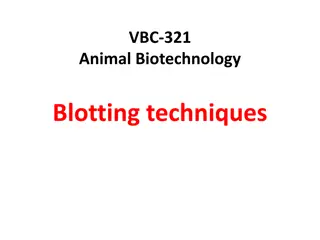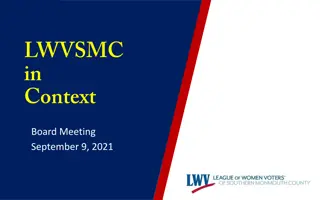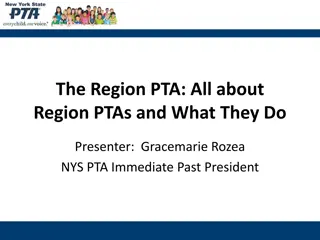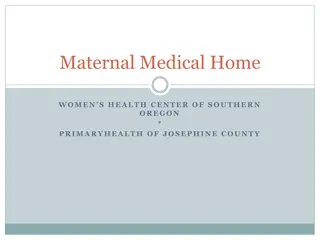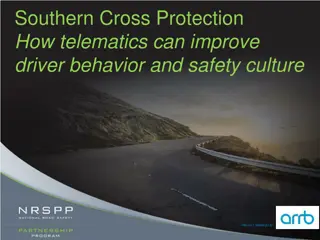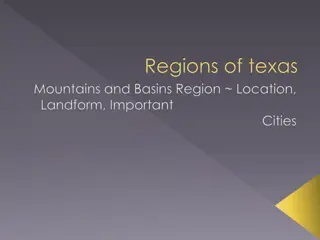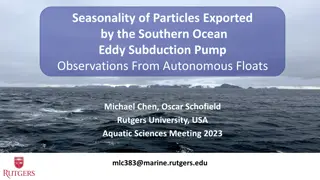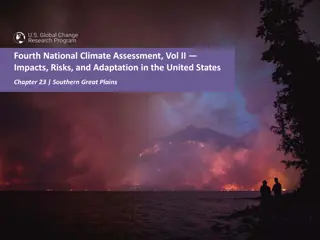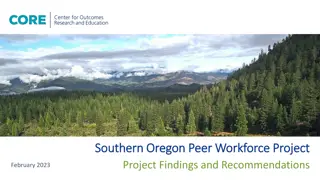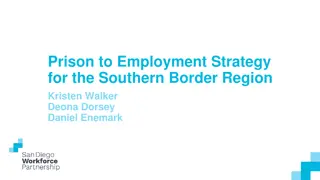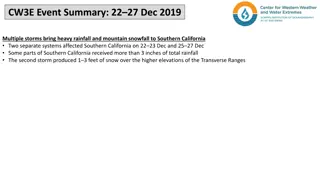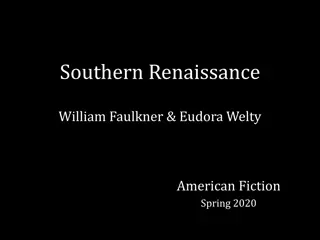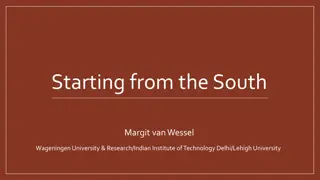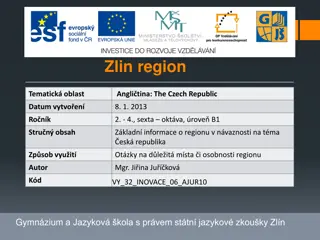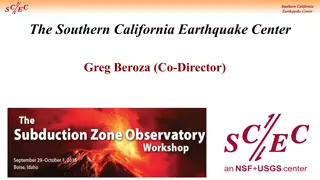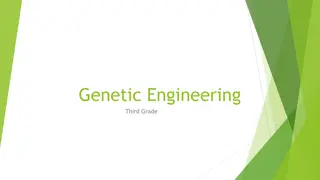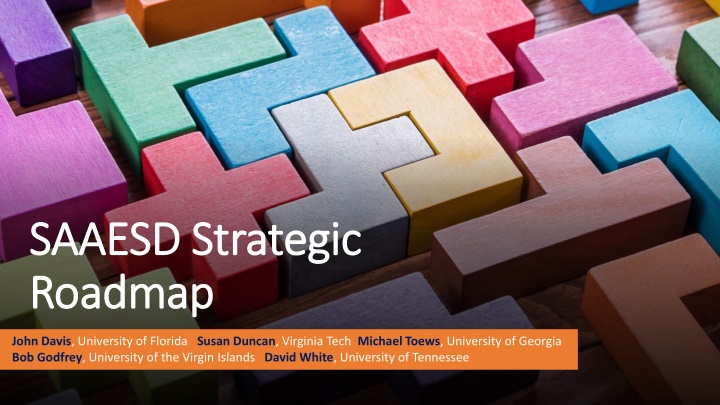
Enhancing Research Collaboration in Southern Region
The Southern Association of Agricultural Experiment Station Directors (SAAESD) plays a crucial role in advocating for high-priority research, coordinating multistate activities, and fostering linkages across institutions. With a mission to address regional, national, and global challenges in food, agriculture, and environmental sciences, SAAESD aims to amplify academic strengths and promote innovative approaches. Stakeholders, including agricultural producers, researchers, educators, and funding agencies, benefit from SAAESD's efforts to facilitate communication, information exchange, and collaboration.
Download Presentation

Please find below an Image/Link to download the presentation.
The content on the website is provided AS IS for your information and personal use only. It may not be sold, licensed, or shared on other websites without obtaining consent from the author. If you encounter any issues during the download, it is possible that the publisher has removed the file from their server.
You are allowed to download the files provided on this website for personal or commercial use, subject to the condition that they are used lawfully. All files are the property of their respective owners.
The content on the website is provided AS IS for your information and personal use only. It may not be sold, licensed, or shared on other websites without obtaining consent from the author.
E N D
Presentation Transcript
SAAESD Strategic SAAESD Strategic Roadmap Roadmap John Davis, University of Florida Susan Duncan, Virginia Tech Michael Toews, University of Georgia Bob Godfrey, University of the Virgin Islands David White, University of Tennessee
SAAESD Programs and Services SAAESD Programs and Services Serve as an active and effective advocate for the Southern regional research system at the regional, national and international levels Provide a forum to identify high priority research opportunities across member institutions Facilitate the development of and coordinate relevant multistate research activities that address the needs of the Southern Region Establish and maintain strong linkages to Extension and related academic, governmental, industrial and private entities Serve as an internal and external information hub for research activities across the Southern Region
Mission The SAAESD amplifies the collective strengths of our academic institutions to expand the vision and enhance their research capacity to collaboratively provide innovative approaches to regional, national, and global challenges in the food, agricultural, environmental, and life sciences. SAAESD SAAESD Strategic Strategic Roadmap Roadmap Vision Transform agricultural, food, natural resources, and human systems throughout the Southern region for a healthier and more sustainable world through consensus and collaborative discovery, translation, application, and adoption.
Stakeholders Stakeholders SAAESD supports open and broad communication to all stakeholders, including the general public, on the value of research and serves as a trusted source of science-based information. Stakeholder Needs: Active and effective advocacy for the Southern regional research system High priority regional research in food, agriculture, and natural resources Effective coordination with Extension, academics, government, industry and private entities Forum for information exchange, training, and communication
Stakeholders Stakeholders To what extent do you consider the following groups of stakeholders to be impacted by SAAESD activities? Greater 81% 63% 53% 53% 50% 44% 44% 40% 38% 27% 27% 25% 20% Neutral 13% 25% 13% 40% 38% 44% 44% 27% 44% 27% 27% 33% 47% Lesser 6% 13% 33% 7% 13% 13% 13% 33% 19% 47% 47% 42% 33% AES Directors ESS/ESCOP Producers AES Faculty Extension APLU Funding agencies Commodity Groups 1890 Research State Gov Students/PD General Public Academics
Collaborative Discovery Five Focus Five Focus Areas Areas Strategic Alliances Enhancing Reputation Effective Advocacy Focus Areas Focus Areas lead to Desired Results Desired Results to attain Goals Goals toward the Vision Vision Creating Impact
Desired Result: Accelerate research and innovation by facilitating collaborative discovery among the Southern land-grant institutions. Relevance: Collaborative discovery harnesses synergies by integrating science from across disciplines and utilizing specialized, advanced capabilities to address the most challenging and complex issues of our time. Focus area 1: Focus area 1: Collaborative Collaborative Discovery Discovery Influences: Food insecurity, climate change, human and community health, biodiversity, rural poverty, agricultural resiliency To what extent do you view this as important focus area for the SAAESD? 81% greater 19% neutral ---------- To what extent do you view this as a desirable outcome for SAAESD? 93% greater ---------- 7% lesser
Strategies: 1. Establish regional research priorities, promoting the development of complementary research platforms and topics to facilitate collaborative research in areas of regional importance. Focus area 1: Focus area 1: Collaborative Collaborative Discovery Discovery 2. Leverage the strengths of specialized faculty and facilities from multiple Southern land-grant institutions to address complex problems that are beyond the capacity of a single SAES. 3. Continually assess the Southern Multistate Research projects portfolio to minimize redundancies and identify gaps as opportunities to create new projects. 4. Address emerging issues in the context of the Southern regional priorities through proactive leadership. 5. Promote convergent, systems-level approaches to broaden the scope of our science.
Desired Result: Extend the reach and impact of our research programs through strong linkages among our institutions with Extension and relevant academic, government, industry, and private entities to foster productive alliances. Focus area 2: Focus area 2: Strategic Strategic Alliances Alliances Relevance: Combined voices reach a broader and more diverse audience to strategically influence, effectively engage, and serve as a resource to amplify the utility and impact of our discoveries. Influences: National research agendas, public-private partnerships, equity and inclusion, state and national policy, next generation of scientists To what extent do you view this as an important focus area for the SAAESD? 88% greater 13% neutral ---------- To what extent do you view this as a desirable outcome for SAAESD? 73% greater 27% neutral ----------
Strategies: 1. Coordinate and promote research initiatives that leverages unique or specialized resources among SAAESD member institutions. Focus area 2: Focus area 2: Strategic Strategic Alliances Alliances 2. Utilize the strengths of all components of the land- grant mission by facilitating partnerships with regional land-grant university associations to advance shared priorities, focusing on ASRED, S-APS, and SRDC. 3. Engage and seek out opportunities for collaborative research and graduate student programs with the 1890 land-grant universities and ARD. 4. Leverage the assets of our land-grant institutions and missions to engage, inform, and influence the dialog of regional, national, and global governmental agencies, including federal funding agencies.
Desired Result: Expand the regional and national reputation of member agricultural experiment stations. Focus area 3: Focus area 3: Enhancing Enhancing Reputation Reputation Relevance: Enhancing the reputation of faculty and institutions within the Southern Region results in a strong voice to influence the national research agenda and provides visionary leadership for research excellence. Influences: Federal research advisory committees, blue ribbon panels, high profile regional centers of excellence, faculty recruitment and retention To what extent do you view this as an important focus area for the SAAESD? 67% greater 20% neutral 13% lesser To what extent do you view this as a desirable outcome for SAAESD? 67% greater 27% neutral 7% lesser
Strategies: 1. Increase stature of faculty in the region as reflected by the number of faculty who are recognized by societal honorifics. Focus area 3: Focus area 3: Enhancing Enhancing Reputation Reputation 2. Integrate institutional research strengths across the regional to increase competitiveness for research centers of excellence. 3. Encourage active participation in ESCOP and APLU leadership and activities as a mechanism for directors to better understand and influence the national research agenda. 4. Build a culture of award nomination from the SAES and share successful strategies.
Desired Result: Serve as an active and effective advocate for the Southern regional research system at the regional, national and international levels. Relevance: Effective advocacy tells the story of our research accomplishments to convey the value of our work and grow the resources that are necessary to deliver innovative approaches to effectively address the complex challenges in agriculture and the life sciences. Focus area 4: Focus area 4: Effective Effective Advocacy Advocacy Influences: Federal capacity and competitive funding, regional and national reputation, federal and state policy, general public To what extent do you view this as an important focus area for the SAAESD? 81% greater 19% neutral ---------- To what extent do you view this as a desirable outcome for SAAESD? 67% greater 27% neutral 7% lesser
Strategies: 1. Advocate for research support on behalf of member SAES primarily through active participation in the APLU BAA and engaging other regional associations. Focus area 4: Focus area 4: Effective Effective Advocacy Advocacy 2. Develop a regional communications strategy bridging local and national efforts to effectively convey the impact and value of our research programs within regional and national contexts.
Desired Result: Facilitate cutting-edge science that matters, balancing fundamental and applied research that is ultimately or directly translatable to addressing the complex problems in the Southern Region and beyond. Focus area 5: Focus area 5: Creating Creating Impact Impact Relevance: Creating impact through long-term intellectual investment combined with training the workforce for the future to address issues facing people today with the tools of tomorrow. Influences: Farmers and growers, forest owners, environmental agencies, general public, Extension, graduate students, postdoctoral researchers To what extent do you view this as an important focus area for the SAAESD? 88% greater 6% neutral 6% lesser To what extent do you view this as a desirable outcome for SAAESD? 93% greater 7% neutral ----------
Strategies: 1. Promote high-quality research that is relevant to end-users to enrich and sustain the forestry, natural resources, agriculture and food systems, and communities of the Southern Region. Focus area 5: Focus area 5: Creating Creating Impact Impact 2. Identify priorities and mobilize research projects that address immediate and long-term growth opportunities in the Southern region 3. Increase size and diversity (i.e., including and beyond USDA) of our respective research funding portfolios. 4. Develop leadership necessary to drive research opportunities that are of particular importance to the Southern region, focusing on economic growth, sustainability, and community enrichment.
Increase scope, diversity and relevance of our collective research portfolios Strengthen collaborative research that has regional relevance Four Four Overarching Overarching Goals Goals Support and develop excellent human capital Showcase member successes, both internally and externally
Goal 1 Goal 1 - - Increase scope, diversity and relevance of Increase scope, diversity and relevance of our collective research portfolios our collective research portfolios Strengthen our current relationship with USDA-NIFA by continuing to address high priority research aligned with their goals, and forge new relationships with other funding agencies. This requires a commitment to collaboration, identifying high-priority research areas where, as a region, we can build on specialized strengths of individual SAES to make impact. To what extent is this goal relevant for SAAESD? 91% greater 9% neutral ----------
Goal 2 Goal 2 - - Strengthen collaborative research that has Strengthen collaborative research that has regional relevance regional relevance Broaden the scope of activities we support to elevate and extend beyond Multistate Research projects, promoting science-based decision support to address the complex, multifaceted challenges facing agriculture and life sciences. Building on areas of synergy among SAESs and incentivizing collaborations will make us more competitive for research funding and stimulate the formation of regional centers of excellence. Likewise, strategic investments in Multistate Research projects can provide incentives to engage in competitive grant programs. To what extent is this goal relevant for SAAESD? 100% greater ---------- -----------
Goal 3 Goal 3 - - Support and develop excellent human Support and develop excellent human capital capital Create opportunities to enhance the recognition and visibility of our faculty at the regional and national levels. Encourage a diverse and inclusive workforce and support regional initiatives for professional development and regional leadership training of directors and faculty at all career stages. Engage graduate students and postdoctoral researchers by providing regional opportunities to broaden their professional experiences. To what extent is this goal relevant for SAAESD? 80% greater 20% neutral ----------
Goal 4 Goal 4 - - Showcase member successes, both Showcase member successes, both internally and externally internally and externally Increase the clarity, consistency, and scale of messaging coming from our research programs by speaking with a coordinated voice on regional issues that complements, reinforces and elevates messages from our respective universities. The scope of our individual communications can be broadened by engaging communicators from our member institutions to effectively network and provide substantive and regular information to generate impactful products. To what extent is this goal relevant for SAAESD? 73% greater 27% neutral ----------
Annual Action Plans Annual Action Plans A Strategic Roadmap Implementation Team will develop annual action plans to: Identify and prioritize specific needs based on input from Southern Advisory Committees, key stakeholders, and members Identify, update, and prioritize emerging opportunities within the five focus areas Evaluate accomplishments and develop annual action plans to support the goals Monitor progress, evaluate results, and share recommendations with SAAESD members


